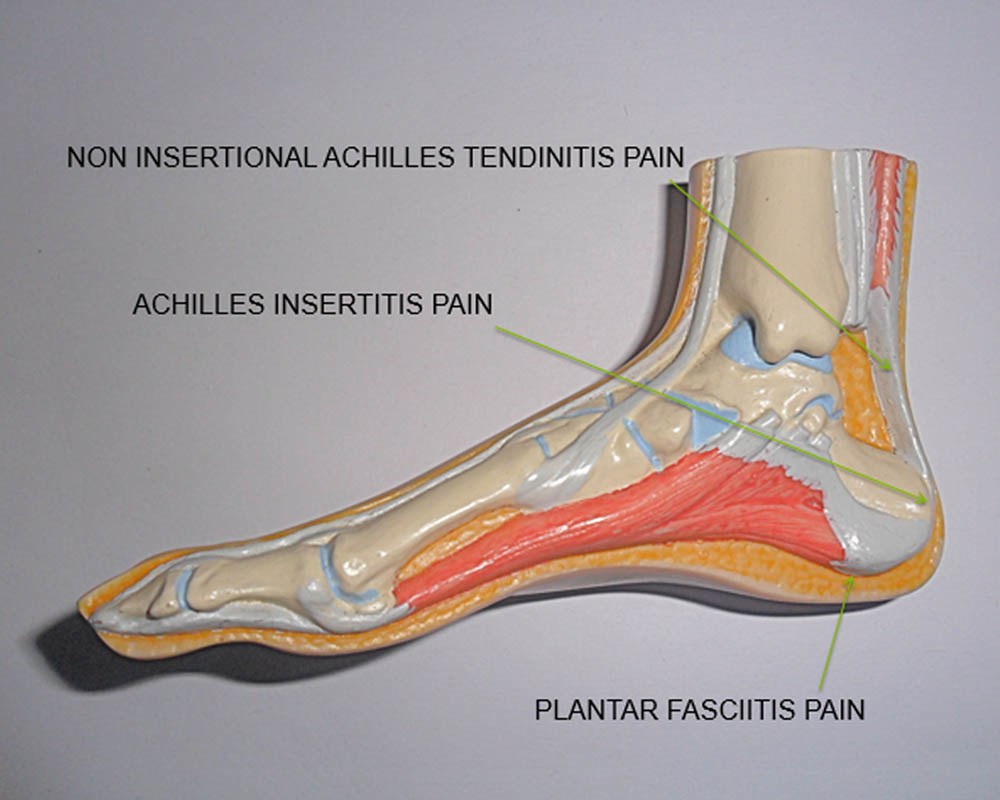Facts about heel pain
Heel pain is caused by a multitude of pathologies, and some of these have layman’s names as well as clinical names.
Names used for heel pain:
- Policeman’s heel or foot
- Postman’s heel or foot
- Plantar fasciitis (plantarfasciitis)
- Plantar fasciosis (plantarfasciosis)
- Plantar fasciopathy (plantarfasciopathy)
- Bruised heel
- Heel spur / bone spurs
- Calcaneal bursitis
- Haglund’s
- Achilles tendonitis / tendinitis
- Achilles tendinosis / tendinosis
- Achilles tendinopathy
- Achilles insertitis
- Achilles non-insertional tendinitis / tendinosis / tendinopathy
- Achilles paratenonitis / paratendonitis
Why so many names?
Over time we have learnt more about the conditions, new names to describe the conditions have developed, but the old clinical names haven’t disappeared. Sorry it is so confusing!

So which one have I got?
Pain behind the heel is usually from an injury to the Achilles tendon.
If the Achilles tendon itself is painful when you press or squeeze it, you have a non-insertional Achilles tendinopathy, meaning pathology in you tendon. This is usually a mixture of inflammation (itis) or degeneration (osis), hence Achilles tendinitis or tendonitis. However it can be the sheath over the tendon that’s inflamed, called the paratenon, which if inflamed is calledparatenonitis.
Try our condition specific AT insole for all Achilles pains
If the pain is on the back of the heel bone (you’ll feel it very firm) you may have an Achilles insertitis, meaning inflammation at the attachment (called the insertion) of the tendon. However the pain can be due to an inflamed sack of fluid by the Achilles known as a bursa. When inflamed it is called a bursitis. Sometimes as a response to irritation at the back on the heel, new bone can make a lump of bone at the back of your heel known as Haglund’s deformity.
Try our condition specific AT insole for all Achilles pains including insertitis
Pain under the heel (plantar surface) is usually caused by an injury to the plantar fascia.
Clinically this is now called plantar fasciopathy, meaning pathology in your plantar fascia. However, because it has inflammation and degeneration in it, it can be called plantar fasciitis (inflamed) or plantar fasciosis (degenerate). Laymen’s names are policeman’s heel / foot or postman’s heel / foot. It usually hurts after exercise, or standing after rest, especially first thing in the morning.
Try our condition specific insole or heelfixkit
Bone of heel spurs are out growths of bone that tend to develop where the bone is under stress. They can occur in the Achilles tendon attachment at the back of the heel and around the plantar fascia attachment under the heel. They are associated with heel pain, but are also common in people without pain. They were once thought to be the cause of heel pain, but probably aren’t. However, bone spurs are still a name commonly given to people who actually have plantar fasciitis.
Deep pain in the heel or heel pain in children have different causes.
Heel pain can also be caused by osteoarthritis in a joint above the heel (subtalar joint), or by deep bruising of the heel bone (calcaneus) of fatty heel pad.
See our X-Line Pressure Perfect Insole
In children heel pain is commonly caused by Sever’s, an issue with the growing heel bone.
See our X-Line Pedipod Insole
Sometimes sciatica can also cause heel pain, as can other local nerve entrapments. These pains are usually not always associated with weight bearing and often are worse at rest or in bed.
